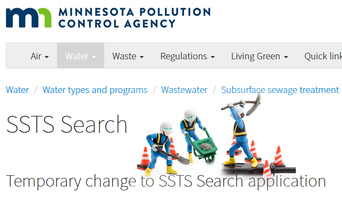 By Cody Robinson
The MPCA is working to develop a more efficient data collection process for the SSTS Annual Report. The goal is to use the SNAP® web-based survey software to cut down the time it takes to prepare, send, receive and consolidate data. This will allow the MPCA to focus more time developing the report content and obtain more accurate, representative data statewide.
What will the new format look like?
Surveys will be sent via email as usual, but instead of an attached spreadsheet, the email will contain a link to the web-based SNAP survey. When the link is selected, a survey, unique to your jurisdiction, will launch. SNAP has the ability to save your progress so you can complete the survey over time. Once you have completed the survey, you can print the report for your records and submit your data to the MPCA with the click of the mouse.
Will there be any significant changes?
Yes and no. The survey will mirror the look and functionality of the spreadsheets used in the past. Program-specific questions and numbers will be the same as before and in a similar order.
The biggest change you will notice, other than the look and nature of taking a web-based survey, is that certain questions must be answered in order to submit the survey. This is due to our continued effort to get more representative statewide data.
Another change will be the tank reporting process. You will be required to report tanks installed by license number and will not be able to see the business names as readily as before. To help ease this transition, there are a few annual report tips and recordkeeping suggestions below.
Is the Annual Report an annual headache?
As the SSTS Annual Report contact from the MPCA, I know there are multiple jurisdictions that experience difficulty with annual reporting requirements. As we head into the 2017 building season, please take note of the following SSTS reporting tips and suggestions to make the process go smoothly come next December:
• Keep the MPCA informed when local contact information changes. Since we use emails to distribute the survey, it is important to keep us in the loop when staff changes; this allows us to send out the survey in a timely manner. Also, make sure you provide your local program information in the contact information section. We want to send the report to the local SSTS administrator as the primary contact, who can then distribute to an inspector or other party to complete the report, if necessary. We try to maintain a running contact list of all SSTS program administrators in the state.
• Record license numbers when you issue building permits. Recording and tracking license numbers when permits are issued will be the best way to easily complete the tank report at the end of the year. Keep in mind that performance systems are only counted as one (1) tank per system. When each permit is issued, record the license number (e.g. L9999 – note this is different from certification numbers, which are prefixed with the letter “C” instead of the letter “L”) and number of tanks installed for that permit. Not only will this make tank reporting a breeze, but it may also prevent unlicensed work from taking place.
• Use your current Annual Report spreadsheet to track your numbers throughout the year. Since the online survey is going to have the same questions as the spreadsheet, why not use the spreadsheet to keep a running total of your program numbers throughout the year? You may even use the tank report tab on the spreadsheet to keep track of common installers in your area. If you would like to receive a copy of your annual report spreadsheet unlocked, please feel free to ask.
I am eager to work with anybody experiencing issues with the SSTS Annual Report. Please feel free to contact me by phone at 651-757-2535 or email .
|
 "At the Minnesota Pollution Control Agency, we really do like to get out and touch base with homeowners and people who are actually in charge of their septic systems," MPCA septic inspector Sadie Wunder (left) recently told the Hubbard County Coalition of Lake Associations in a meeting covered by the local paper, the Park Rapids Enterprise. Her quotes here are from that article.
"Empowering homeowners with the basics of system function, they can better understand why it is important to think about what is going down the drain. Simply put, all water is connected," she said. "And as you know, Hubbard County is full of lakes. Minnesota is full of lakes. And we want to make sure we're doing our best to protect the resources we have."
"Just a few tips can make a huge difference when it comes to protecting
your septic system," Wunder said. And you're not just protecting the environment -- a new septic system can cost between $15,000 and $30,000.
"That's a huge part of your property value," Wunder said. "By protecting your system, by taking care of it, by doing a few things here and there, you are not going to have to replace it."
Septic system maintenance 101
- Septic system additives are completely unnecessary. "Your body produces additives. You don't need to add anything."
- Rather than using chemical drain decloggers, buy a plumber's snake or clog cable.
- Unneeded medications should go in the regular garbage or to a collection center/program, such as the one in Hubbard County.
- Fats and oils should go in the trash, not the toilet.
- And probably most important, septic tanks need to be cleaned/pumped by a licensed professional every three years to remove the solids that accumulate. Failing to do so can allow solid particles to get to the drainfield where they can affect the system's ability to treat the liquid waste and potentially require a replacement of the system.
Get the full story here.
|
 Thank you for your patience as the MPCA continues its data management system update process during which the online SSTS certification/license search tool has been down.
We understand that it has recently been more difficult to validate licensure information, and we apologize for any inconvenience this may cause.
We hope to have the SSTS Search Tool up again soon. Thank you again for your continued patience as we work to improve your user experience.
In the meantime, valid SSTS license information is updated weekly and can be found here, along with detailed instructions for searching and sorting the spreadsheet.
Questions about SSTS certification and continuing education can be directed to the SSTS hotline at: 651-757-2201 or email.
|
During the period of January - March, 2017, the MPCA completed 47
enforcement cases. Three of the 47 cases (6 percent) were SSTS
related. They were located in Canby ($3,450), Rochester ($1,565, unlicensed work), and Mabel ($500, straight pipe).
More information can be found on the MPCA’s Website.
The MPCA has been working with the Minnesota Onsite Wastewater Association on a rule change related to when a facility is required to get a State Disposal System (SDS) permit vs. a local permit. To help answer this question under existing rules, a facility could measure its actual wastewater flows or use “table values,” values stated in rule for various types and sizes of facilities.
If a facility did not measure flows they needed to use table values in determining the type of permit needed. If they did measure flows, they needed to use the greater of the two values to determine the type of permit required. The most significant proposed change would change rule language to indicate a facility can choose to use either table values or measured values to determine the type of permit required.
The change is expected to be in place for the 2018 season.
Continuing education (CE) requirements help certified SSTS professionals maintain the expertise they need to be successful in the SSTS Industry. All approved SSTS training receives accreditation to award either direct or related credits to those who attend. Below, we dispel the most common myths about training that awards related credits.
-
Related CE Credits Cannot Be Used to Renew My SSTS Certification
False. Related (or indirect) continuing education credits are tracked by the MPCA and do count towards your renewal requirement. Individuals with any combination of Installer, Maintainer and Service Provider Certifications must earn 12 credits (or hours) every 3 years. Individuals with a combination of certifications that include any level of the Designer or Inspector specialty areas must earn 18 credits every 3 years with at least 6 credits of Soils CE.
-
Related CE Credits Are Worth Less than Direct CE Credits
False. Related CE Credits are valued equally to direct CE credits when the MPCA evaluates your renewal requirements. However, those with a 12-credit requirement cannot count more than 6 related credits towards renewal every 3 years. For example, you could meet your requirement with 6 related credits + 6 direct credits. Those with an 18-credit requirement cannot count more than 9 related credits every 3 years. In this case, you could meet your requirement with 9 related credits + 3 direct credits + 6 soils direct credits.
-
CE that Awards Related Credits Covers Topics of No Value
False. You earn related credits at events that do not provide training specific to SSTS in Minnesota. Learning about septic systems at a national conference or about emerging technologies is undeniably valuable. However, you would earn related credits from attending these training events because you have not received targeted education or updates on Minnesota Rules Chapters 7080-7083. The MPCA requires a minimum amount of direct credits to ensure that individuals are exposed to its SSTS Rules during each 3-year CE period.
Questions? Contact MPCA SSTS Licensing & Certification staff, Jane Seaver, or 651-757-2711.
|